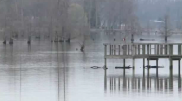Tennessee Ash Flood: A Brief History
Just before 1 a.m. on Dec. 22, 2008, a dam holding back a retention pond at a power plant run by the Tennessee Valley Authority broke, releasing a mix of water, ash and mud. Hundreds of acres and 12 homes were buried in toxic sludge.
As cleanup methods began, the TVA tired to contain the potential release of toxic pollutants and planned to trap a layer of ash that was on its way down the Emory River.
On Dec. 23, TVA president Tom Kilgore said the company was up to date on maintenance issues and blamed the rupture on cold weather and an increase in rain.
Early tests showed no threat to drinking water, but environmentalists worried the ashy sludge that coated Tennessee neighborhoods posed health risks. Despite TVA's cleanup efforts, including bringing in 30 pieces of equipment and more than 100 workers, environmentalists sharply criticized the company for a disaster they felt was "completely avoidable."
A news statement released by TVA claimed there was no threat to the environment, but people continued to question whether or not the disaster contributed to the death of hundreds of fish found near the plant.
By Dec. 29, high levels of arsenic and heavy metals were found by the Environment Protection Agency, issuing further investigations. The agency determined water levels were not harmful to humans, although slightly above safe drinking water standards.
The ash needs to be removed from the river, but I’m real sorry that somebody else is going to get stuck with this stuff.
The estimate of the spill was updated to 5.4 million cubic yards, or more than 1 billion gallons.
Inventory reports obtained by The New York Times showed that the coal plant deposited at least 2.2 million pounds of toxic sludge (containing arsenic, lead, manganese and more) in the retention pond over the course of one year.
Although TVA officials had maintained that the spill was not toxic, a week after the spill the company issued a statement recommending residents to avoid contact with the spillage.
Water tests met EPA drinking standards, however samples were taken from a site upstream of the spill.
After a second waste pond ruptured, TVA officials met with a U.S. Senate committee to explain their plans. The cause of the spill was still under investigation, and representatives of the company suggested that any evidence may have been destroyed in the spill.
New TVA chairman Mike Duncan held his first board meeting, announcing that he planned to tackle the federal utility's financial trouble by finding "efficiencies" and claiming to give priority to protecting the environment.
By June 2009, TVA planned to ship the toxic spillage to an Alabama landfill. However, only 3 percent of the estimated 5.4 million cubic yards had been contained.
Meanwhile, communities affected by the spill were struggling to reclaim their lives. Although many received compensation, property remained destroyed due to lax cleanup efforts by the company.
A biology research team from Appalachian State University reported that fish sampled from the affected area had an extremely high level of toxicity, suggesting that they may have been poisoned before the spill.
A year (and a billion dollars) later, TVA was still struggling to contain the disaster. Although efforts to dredge toxins out of the river continue "nonstop", another 1.4 million tons remain on land.
According to a study released by Duke University in November 2010, toxic contamination remains in river-bottom sediment. Even so, the EPA has not yet designated coal ash as hazardous waste.





